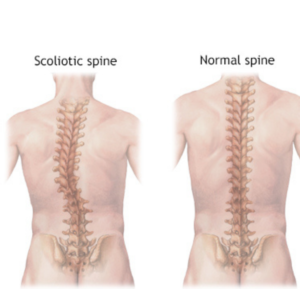
Dr Tushar Pisal- Scoliosis Treatment in Pune, PCMC
What is Scoliosis?
Scoliosis means a person will have a sideways C or S shaped curve in their spine. For a doctor to diagnose scoliosis, the Cobb angle — a measure of the curvature — must be at least 10 degrees. Scoliosis can appear at any age but often occurs between ages 10-12 yrs. And rarely presents in infants.
In major cases, there is no known cause of scoliosis & this called as idiopathic scoliosis. In some other cases, scoliosis may have an association with cerebral palsy, muscular dystrophy. Alternatively, it may be a birth abnormality.
Doctors will classify these spinal curves as structural or non-structural. A structural curve is permanent and may be due to any medical condition or traumatic injury. A non-structural curve is temporary, meaning that the spine is structurally normal.
Types of Scoliosis:
- Congenital scoliosis
- Early onset scoliosis
- Adolescent idiopathic scoliosis
- Degenerative scoliosis
- Neuromuscular scoliosis
- Scheuermann’s kyphosis
- Syndromic scoliosis


FAQ- Scoliosis Treatment in Pune, PCMC
Scoliosis is most common in the later stages of childhood or the early teenage years. It is occurring more common in females than in males. Scoliosis of spine is not always noticeable, but some people with this condition may lead to one side or have uneven shoulders or hips due to the scoliosis curve of the spine.
Causes of Scoliosis:
• Cerebral palsy: it is a group of nervous system disorders that affect movement, learning, hearing, seeing, and thinking • Muscular dystrophy: it is a group of genetic disorders that result in muscle weakness • birth defects that affect an infant’s spinal bones • spinal injuries or infections • Neuromuscular conditions • Congenital scoliosis • Osteoporosis • Other causes such as Poor posture, carrying backpacks or satchels, connective tissue disorders, and some injuries can cause spinal curvature
Symptoms of scoliosis in adolescents
The most common type of scoliosis appears in adolescence and is known as adolescent idiopathic scoliosis. It can affect ages between 10-18 yrs. Symptoms can include the following: • the head may appear a bit off centre • the ribs on each side may be slightly different heights • one hip may be more prominent than the other • one shoulder or shoulder blade may be higher than the other • the person may lead to one side Some types of scoliosis can cause back pain, but it is not usually very painful. This symptom is more common in older adults than younger. Symptoms in infants In infants, symptoms can include: • a bulge on one side of the chest • consistently lying with the body curved to one side • in severe cases, problems with the heart and lungs, leading to shortness of breath and chest pain
Diagnosis of Scoliosis:
Dr. Tushar will carry out a physical examination of the spine, ribs, hips, and shoulders. With the aid of a tool called an inclinometer, or scoliometer, the doctor can measure the degree of scoliosis. If an angle found greater than 10 degrees indicates scoliosis. Imaging scans such as X-Rays, CT Scan & MRI can help the doctor assess the shape, direction, location, and angle of the curve.
Treatment of Scoliosis
Deformative correction and spinal fusion surgeries are the best option to treat the scoliosis.